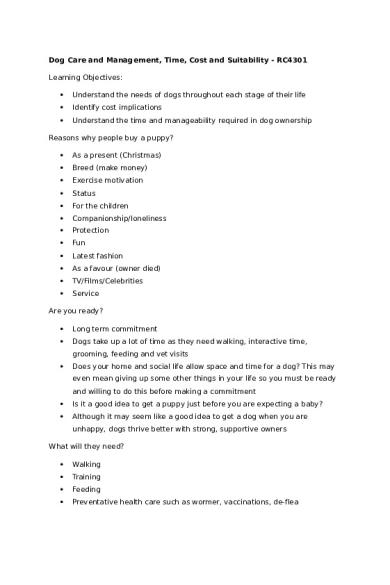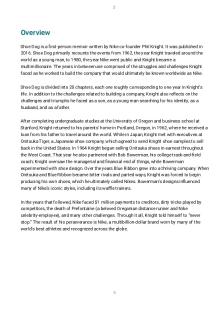Lesson 4 - Dog Care and Management PDF

| Title | Lesson 4 - Dog Care and Management |
|---|---|
| Author | Lauren Dowdeswell |
| Course | Domestic Animal Husbandry & Welfare |
| Institution | University of Chester |
| Pages | 7 |
| File Size | 163.6 KB |
| File Type | |
| Total Downloads | 41 |
| Total Views | 121 |
Summary
This was all about how much it costs to have a dog, what people need to do, the time dogs need and whether to get a puppy or adult dog...
Description
Dog Care and Management, Time, Cost and Suitability - RC4301 Learning Objectives:
Understand the needs of dogs throughout each stage of their life
Identify cost implications
Understand the time and manageability required in dog ownership
Reasons why people buy a puppy?
As a present (Christmas)
Breed (make money)
Exercise motivation
Status
For the children
Companionship/loneliness
Protection
Fun
Latest fashion
As a favour (owner died)
TV/Films/Celebrities
Service
Are you ready?
Long term commitment
Dogs take up a lot of time as they need walking, interactive time, grooming, feeding and vet visits
Does your home and social life allow space and time for a dog? This may even mean giving up some other things in your life so you must be ready and willing to do this before making a commitment
Is it a good idea to get a puppy just before you are expecting a baby?
Although it may seem like a good idea to get a dog when you are unhappy, dogs thrive better with strong, supportive owners
What will they need?
Walking
Training
Feeding
Preventative health care such as wormer, vaccinations, de-flea
Pet insurance
Bedding
Leads, collars, harnesses
Dental care
Grooming
Toys
Time
Enrichment
Socialisation
Routine
Daily Requirements:
Constant access to clean water
Feeding - how does this change with age, breed, exercise?
Daily health checks - observe his behaviour and investigate any changes, whilst grooming /stroking check for injuries or problems
Grooming - frequency depending on coat type
Exercise - walk and play
Companionship and attention
Mental stimulation - walks and training
Taking on a dog means that someone will have to be available throughout the day to let it go to the toilet and offer it companionship and exercise
Exercise requirements:
All dogs need regular exercise to keep them fit and healthy
Feeding should match exercise, so the dog’s weight and energy level are corrected, diet requirements
Most dogs enjoy exercise and will take as much exercise as the owner can give. Remember the warm-up and cool off period
Large dogs may need to have their exercise restricted for the first 12-18 months as they grow - clumsy, not fully grown
With very active/hyperactive dogs which are always on the go, training and mental stimulation can be more tiring than just physical exercise and should be incorporated into their walks/or training sessions
Games:
Mental stimulation
It is also good if the dog can learn to play alone
Choose dog toys sensibly - too big/small, destroyed?
Play with other dogs, controlled and supervised
Dog Training:
Training fulfils many of the dog’s needs - mental stimulation is far more stimulating than physical exercise
Methods of training should be fair but fun - positive reinforcement
What are the benefits of good positive reinforcement training? o
Improved relationship/bond with the dog, built on mutual respect and trust
o
Increased ability to communicate with the dog and understand him in return
o
Greater control - ability to help the dog respond appropriately in difficult situations
o
A well-trained dog can be controlled without the need of physical handling/restraint
o
The dog becomes accustomed to co-operating and learns the benefits of doing so
o
Happy dog = happy owner
Dog Training:
Initial training will consist of o
Handling, rules and manners
o
Socialisation
o
Obedience training
Teach good manners right from the start o
Leaving food
o
Not jumping up
o
Giving way at doors
Training is necessary for the dog and owner/handler to live together harmoniously
Dogs need rules to fit comfortably into society
Training can be costly if paying to go to classes or paying a behaviourist to help with training
Behavioural issues are the most common reason for euthanasia in young dogs
Grooming:
Cleanliness
Health - the coat needs to be kept clean, removes dead hair and prevents tangles which could cause discomfort to the dog
Accustom - accustoms the dog to handling
Inspection - inspect the dog all over for any health issues or injuries
Coat, skin, ears, eyes, nose, feet, external parasites, teeth, claws, anal glands and dew claws
Relationship - bonds the dog to the handler, important in the showing world
Costly and time consuming
Specific Requirements:
Puppies need a lot of training and a lot of time spent with them. They are babies after all and need to have someone looking after them
Older dogs may need to be exercised little and often and may also need to go to the toilet more
Larger dogs will need more space to run around
Size, breed, daily requirements, age, mental stimulation, training and grooming requirements should all be considered when deciding on a breed and what time you can dedicate to a dog
Cost:
Dogs require feeding and the bigger the dog the more food they will require
Dogs need preventative health care such as wormers, grooming and yearly vaccinations
Dogs require pet insurance as medications and vet treatments can be costly without o
Costs depend on the company, policy chosen and the breed
Medication costs increase with the weight of the dog, the heavier the dog, the more medication is required, so this will increase the cost
Training and grooming can also be costly if required and so can get someone to look after the dog while the owner is at work
Year long insurance policy or life-time policy
Feeding my dog:
Depends very much on the size and breed of the dog
Research will need to be done on different types of food to determine what best suits the dog’s breed and lifestyle
Working dogs that have lots of energy such as the Border Collie will have high energy requirements and therefore many need a specific type of food which could be more costly
Raw diet - not accepted in kennels or vets due to disease risk of raw meat
Chews and treats to keep the dog’s teeth in good health
Prescription diets?
Other examples?
Preventative Veterinary Treatment:
Vaccinations/neutering
Health care checks
Grooming
Bedding:
Dogs should have their own bed/area and their right to privacy and their own space should be respected
The dog’s bed should be somewhere the dog can feel secure and safe
Dogs can tolerate cold, but not always damp and drafts so position the bed accordingly
Choose one that is suitable for your dog and fits into your lifestyle
Destructive dogs will need to avoid softer beds such as beanbags and padded beds and may be better off with a plastic bed or crate with blankets
Bedding should be cleaned regularly
Crates:
Safe space
So they know their position in the pack
So they know to sleep and not tempted to play at night
Gets them trained for kennels
Whilst humans are eating
Can travel
Some have had bad experiences with crates
Walking Aids:
Leads - for walking
Collars - all dogs should wear one
Harness - used for dogs that have problems with collars
Halti - gives more control
Puppies:
Puppies are very costly and time consuming
Constant care and attention
Puppies need lots of training and especially in the first 14 weeks
Socialisation is important and requires time
Puppies require an owner that is willing to dedicate the time to training
Adults:
The life expectancy of breeds differs but with better food and veterinary care, dogs are living longer
Middle aged is classed as 7 years+ but bigger dogs may age faster
With age, the body slows down and uses less energy and there is an increased tendency to deposit fat dogs may put on weight
Some dogs may lose weight due to poor digestion or illness
As the dog becomes less active, they require less energy, senior diets are lower in calories but may be higher in protein
The dog may require smaller more frequent meals
To check weight, you should be able to see the waist when the dog is viewed from above and feel the ribs when lightly touching the dog’s side
Older dogs can be more time consuming and may not be suitable for someone with a busy lifestyle Rehoming
Breeder
-
May not know background May have behavioural issues Already has personality Helping a dog in need of a home Can choose bread and age and based on temperament Rewarding
-
With you from the start so full history known Will need training from scratch Personality can be determined Paying a breeder a substantial amount of money for a specific breed Personality yet to be determined...
Similar Free PDFs

Nclex- Management of Care
- 11 Pages

Lesson 4 Verbs and Practice
- 2 Pages

Shoe Dog Summary and Analysis
- 41 Pages

Lesson 1 office management
- 24 Pages

Cross Cultural Management lesson
- 11 Pages

Lesson 3 - management notes
- 2 Pages

4. Risk Analysis and Management
- 3 Pages
Popular Institutions
- Tinajero National High School - Annex
- Politeknik Caltex Riau
- Yokohama City University
- SGT University
- University of Al-Qadisiyah
- Divine Word College of Vigan
- Techniek College Rotterdam
- Universidade de Santiago
- Universiti Teknologi MARA Cawangan Johor Kampus Pasir Gudang
- Poltekkes Kemenkes Yogyakarta
- Baguio City National High School
- Colegio san marcos
- preparatoria uno
- Centro de Bachillerato Tecnológico Industrial y de Servicios No. 107
- Dalian Maritime University
- Quang Trung Secondary School
- Colegio Tecnológico en Informática
- Corporación Regional de Educación Superior
- Grupo CEDVA
- Dar Al Uloom University
- Centro de Estudios Preuniversitarios de la Universidad Nacional de Ingeniería
- 上智大学
- Aakash International School, Nuna Majara
- San Felipe Neri Catholic School
- Kang Chiao International School - New Taipei City
- Misamis Occidental National High School
- Institución Educativa Escuela Normal Juan Ladrilleros
- Kolehiyo ng Pantukan
- Batanes State College
- Instituto Continental
- Sekolah Menengah Kejuruan Kesehatan Kaltara (Tarakan)
- Colegio de La Inmaculada Concepcion - Cebu








